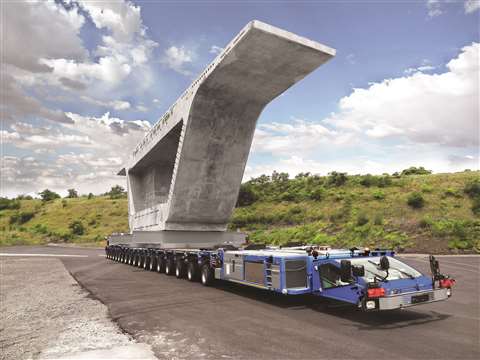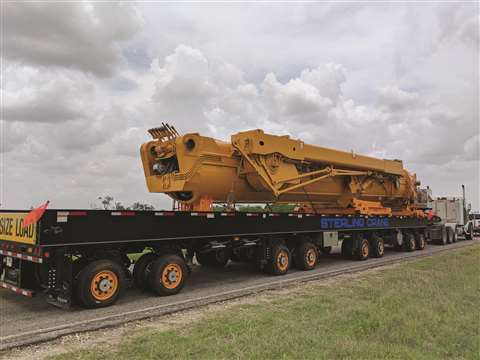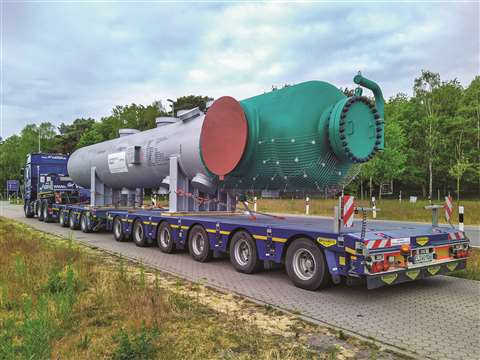Specialized transport: regulation weight
12 October 2020
As Goldhofer says, “Sometimes just a few centimetres of running height or kilogrammes of deadweight are decisive for avoiding a lengthy detour.” For that reason, specialized transport OEMs are focused on making their products as compact and lightweight as possible, without compromising on performance or roadability. It is a tricky balance to strike.
For its own designs, Golhofer says that “in addition to the basic principle of combining low deadweight with high axle loads, the focus in the development stage is on making the vehicles as versatile as possible so that they comply with a large number of different national regulations as standard.
“Haulage companies…benefit from the simple fact that they do not have to use different vehicles from country to country and save time and money by not having to transfer the cargo from one vehicle to another. And the degree of regulatory variation, which has to be covered by the standard vehicle or a special version, is considerable: from height and weight limits in Europe to changing rules for track width in the USA.”
Goldhofer, like its competitors, uses finite element methods to find the most effective design profile; “These results are then incorporated into new products and product enhancements, ranging from new special steels to reduced weld seams and innovative cargo deck coverings. This enables us to achieve further significant improvements in terms of deadweight, axle load, loading height and stability.”
For example, its new low-wear polymer deck coating is resistant to UV light and offers better surface friction for load safety, but is thinner and lighter than previous coatings, with weight savings of up to 500 kg per vehicle.

For TII, manufacturer of the Scheuerle, Kamag and Nicolas brands, the need to meet the requirements of national regulations is a major design focus. “In this way”, it says, “TII Group ensures that customers can use their vehicles efficiently. This in turn depends heavily on the type of load. For example, the new EuroCompact FL02 and FL03 series have been optimised for a low weight as well as for the lowest possible loading height.
“This makes it easier for customers to pick up a wide variety of goods and, at the same time, it protects the road infrastructure, which has to be renewed in many regions. Until then, axle loads often must be reduced or bypasses taken, which costs time and money.” TII ads that the new EuroCompact series comply with the single-driver regulation despite the telescopic extension, because their turning circle is sufficiently compact.
Free movement
Faymonville says its trailers are designed “so that transport permits can be obtained as easily as possible in accordance with national and-or international legislation, the legally maximum permissible axle loads can be achieved and the costs for empty runs are kept as low as possible.”
It adds that Europe, Asia Pacific, Africa and South America use vehicles with very similar technologies and dimensions, while in North America it “has completely different requirements in terms of technology and design.”
It tries to find the optimum compromise between a low tare weight and robustness, but argues that its many years of experience “have shown that striving for ever lower tare weights is not expedient with these special vehicles….the payload is always at the forefront of the project objectives.”
Ohio, USA-based Nelson Manufacturing Company says differing road regulations between US States “often throws a wrench in some plans. It makes it more difficult to design a trailer for a customer who wants to haul a particular payload all over the continental US.”
Nelson says there are many ways to save weight on a trailer, and the key is finding the sweet spot between reducing weight and maintaining structure and capacity; “We use any way that we can find to save weight by utilising aluminium wheels, fenders, lighter suspension components, or replacing any steel parts with aluminium where design criteria allows. If need be, we can also use 130KSI steel in high stress areas allowing us to reduce the amount of steel necessary.”

Meanwhile, Broshuis says trailers need to be designed to be “as low, light, and short as possible, so it’s more flexible in use. Thanks to our newest computer technology we can see exactly where we have to make our trailers stronger, but also where we can reduce weight.”







